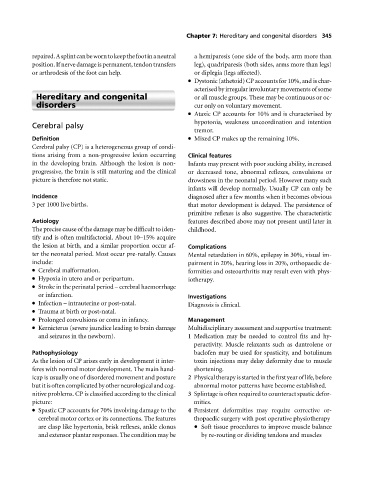Page 349 - Medicine and Surgery
P. 349
P1: FAW
BLUK007-07 BLUK007-Kendall May 25, 2005 18:18 Char Count= 0
Chapter 7: Hereditary and congenital disorders 345
repaired.Asplintcanbeworntokeepthefootinaneutral ahemiparesis (one side of the body, arm more than
position. If nerve damage is permanent, tendon transfers leg), quadriparesis (both sides, arms more than legs)
or arthrodesis of the foot can help. or diplegia (legs affected).
Dystonic (athetoid) CP accounts for 10%, and is char-
acterised by irregular involuntary movements of some
Hereditary and congenital or all muscle groups. These may be continuous or oc-
disorders cur only on voluntary movement.
Ataxic CP accounts for 10% and is characterised by
hypotonia, weakness uncoordination and intention
Cerebral palsy
tremor.
Definition MixedCP makes up the remaining 10%.
Cerebral palsy (CP) is a heterogeneous group of condi-
tions arising from a non-progressive lesion occurring Clinical features
in the developing brain. Although the lesion is non- Infants may present with poor sucking ability, increased
progressive, the brain is still maturing and the clinical or decreased tone, abnormal reflexes, convulsions or
picture is therefore not static. drowsiness in the neonatal period. However many such
infants will develop normally. Usually CP can only be
Incidence diagnosed after a few months when it becomes obvious
3per 1000 live births. that motor development is delayed. The persistence of
primitive reflexes is also suggestive. The characteristic
Aetiology features described above may not present until later in
The precise cause of the damage may be difficult to iden- childhood.
tify and is often multifactorial. About 10–15% acquire
the lesion at birth, and a similar proportion occur af- Complications
ter the neonatal period. Most occur pre-natally. Causes Mental retardation in 60%, epilepsy in 30%, visual im-
include: pairment in 20%, hearing loss in 20%, orthopaedic de-
Cerebral malformation. formities and osteoarthritis may result even with phys-
Hypoxia in utero and or peripartum. iotherapy.
Stroke in the perinatal period – cerebral haemorrhage
or infarction. Investigations
Infection – intrauterine or post-natal. Diagnosis is clinical.
Trauma at birth or post-natal.
Prolonged convulsions or coma in infancy. Management
Kernicterus (severe jaundice leading to brain damage Multidisciplinary assessment and supportive treatment:
and seizures in the newborn). 1 Medication may be needed to control fits and hy-
peractivity. Muscle relaxants such as dantrolene or
Pathophysiology baclofen may be used for spasticity, and botulinum
As the lesion of CP arises early in development it inter- toxin injections may delay deformity due to muscle
feres with normal motor development. The main hand- shortening.
icap is usually one of disordered movement and posture 2 Physicaltherapyisstartedinthefirstyearoflife,before
butitisoftencomplicatedbyotherneurologicalandcog- abnormal motor patterns have become established.
nitive problems. CP is classified according to the clinical 3 Splintage is often required to counteract spastic defor-
picture: mities.
Spastic CP accounts for 70% involving damage to the 4 Persistent deformities may require corrective or-
cerebral motor cortex or its connections. The features thopaedic surgery with post operative physiotherapy
are clasp like hypertonia, brisk reflexes, ankle clonus Soft tissue procedures to improve muscle balance
and extensor plantar responses. The condition may be by re-routing or dividing tendons and muscles

